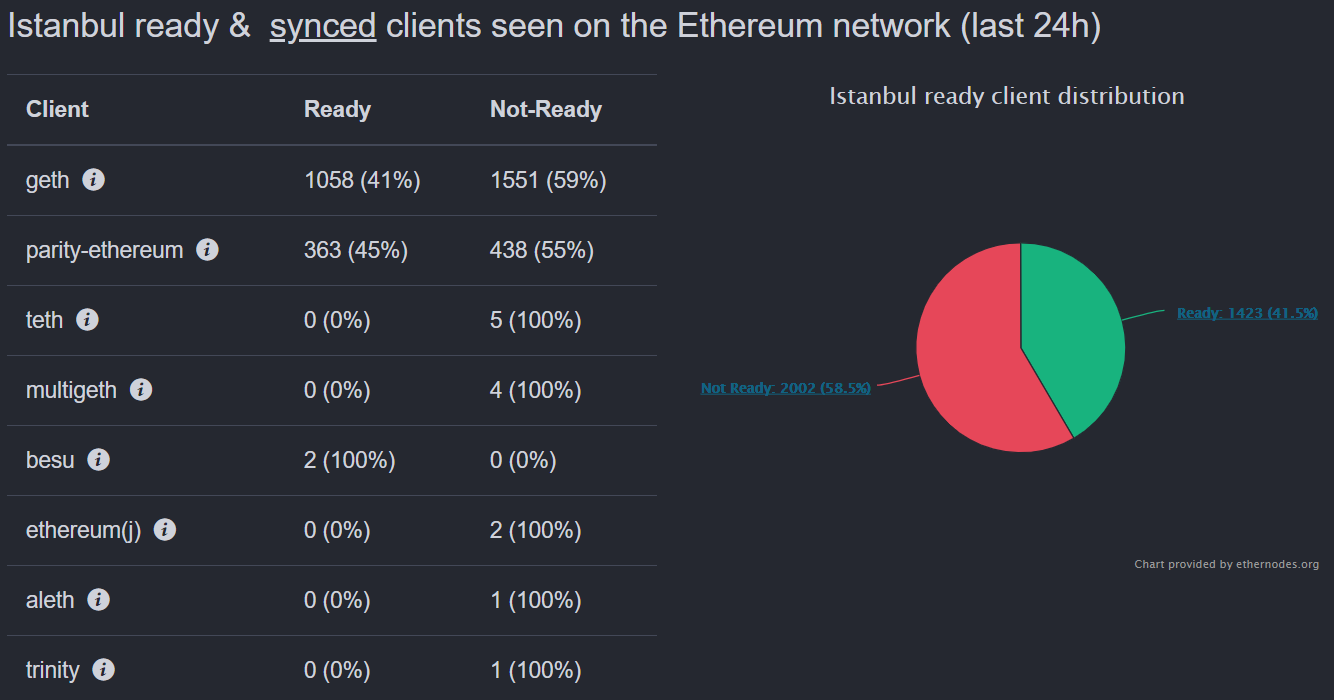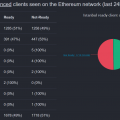On Sunday, December 8, the planned Ethereum hard fork called Istanbul is due to take place.He'll becomeeighth major network updatesecond in terms of cryptocurrency capitalization and is expected to usher in the transition to ETH 2.0 - a new stage in the evolution of the project, which provides for the future migration to the Proof-of-Stake consensus algorithm.
In this article, we will consider what changes await the Ethereum network after the upcoming upgrade, and what awaits it in the future.
Ethereum was originally conceived asdecentralized Internet - a blockchain platform on the basis of which companies can create products and smart contracts. Today Ethereum is a haven for numerous decentralized applications (dApps) - from various blockchain games and projects with its own tokens to the increasingly popular decentralized finance (DeFi). However, as their number grows, the platform is experiencing more and more problems with transaction throughput.
Ethereum-based consensus algorithmProof-of-Work (PoW) perfectly copes with its task in the case of bitcoin, ensuring the security of the first cryptocurrency, however, for broadcasting, this mechanism, according to the leading developers of the project, is more likely to become an obstacle. This is especially true for enterprise solutions that require fast transactions and high network scalability. In addition, often criticism of mining cryptocurrencies based on PoW is also heard because of high energy consumption and negative environmental impact.
The challenge facing Ethereum is even moreserious, given the fact that since 2013, when the platform was launched, the overall picture in the market has changed a lot. Today, Ethereum is no longer the only smart contract platform, experiencing intense competition from a number of other projects that offer high scalability in combination with lower fees.
All this puts Ethereum inevitable choice: either go through a difficult path of change, or with a high probability of losing their current status as a leading platform for application developers.
However, such prospects were hardly ever included in the plans of the developers, and the further evolution of Ethereum has long been a key subject of heated debate in the community.
Vitalik Buterin: scalability of the Ethereum network is a “problem area”, the blockchain is almost full
The Istanbul update itself consists of two parts, the first of which should take place approximately on the night from Saturday to Sundayon the block # 9069000. The second part, called Berlin, is tentatively planned for the first half of 2020.
The upcoming upgrade, among other things, will provideEthereum’s compatibility with Zcash cryptocurrency will increase the scalability of solutions based on zero-disclosure proof technology (SNARKs and STARKs), as well as change the cost of gas of various operating codes (opcodes) in order to complicate block spam and increase the network's resistance to DoS attacks.
Included in Istanbul EIP’s
EIP (Ethereum Improvement Proposals) -suggestions for improving the Ethereum protocol, which are submitted for discussion by developers before each hard fork. In preparation for Istanbul, six such proposals were approved:
EIP-152is a proposal that introduces a new precompiled contract that implements the F compression function used in the Blake2 cryptographic algorithm.The goal is to create interoperability between the Ethereum Virtual Machine (EVM) and Zcash or other cryptocurrencies based on the Equihash protocol.
EIP-1108– is aimed at reducing the pre-compiled cost of gas (commission for the execution of smart contracts), which in turn will have a positive impact on the development of a number of solutions in the field of privacy and network scaling.
EIP-1344is a proposal to use a chain ID to prevent transactions replay attacks between different blockchains.Until now, there were no clear specifications for setting a chain ID for a particular network, and everything was determined manually by the customer operators and communities of a particular network.
EIP-1884– this proposal is aimed at increasing the cost of gas for certain opcodes, which, against the backdrop of the rapid growth of the Ethereum network, began to consume more resources (CPU, memory, etc.).According to the developers, in this way it will be possible to achieve a better balance between gas consumption and resource consumption.
EIP-2028– The proposal aims to reduce the cost of gas when calling on-chain data from the current 68 units per byteThis will increase the throughput of the network, as it will be possible toPut more data.
IP-2200– offers a structured definition of gas metering changes for the SSTORE opcode.This will create additional opportunities for the use of contract storage systems, reducing unnecessary fees.
The second part of the upgrade (Berlin) is expectedwill happen before the end of June 2020. It should include proposals that require more time for testing, for example, EIP-1057, a considerable controversy - a modified ProgPoW mining algorithm aimed at reducing the influence of ASIC devices.
Ultimately, as the developers hope, byBy completing both parts of the upgrade, the Ethereum network will become faster, cheaper, and more scalable. They expect all this to be achieved without compromising the decentralization and flexibility of the network.
On the way to Ethereum 2.0
The activation of Istanbul should also mark the beginning of the transition to Ethereum 2.0, a new stage in the evolution of the network that marks the migration to the Proof-of-Stake (PoS) consensus algorithm.
Ethereum founder Vitalik Buterin announced the transition to a new version of the platform called Serenity a year ago at the Devcon4 conference in Prague.
Casper protocol, which should result inEthereum will switch to the Proof-of-Stake algorithm; it has been under development for several years. Due to its combination with sharding aimed at scaling the network (a lot of parallel circuits connected to the main one to execute various smart contracts and ensure the operation of decentralized applications), the project was also sometimes called Shasper.
However, as Buterin said then, this is not the right name, and it is best to return to the once proposed Serenity.
“Serenity is a worldwide computer, and that is what it should be, and not some kind of smartphone of 1999, on which you can play a snake,”- he said.
In May 2019, the Ethereum Foundation, a non-profit organization that promotes and supports the development of the Ethereum ecosystem, announced the allocation of $30 million for the development of key ecosystem projects, of which $19 million will goto the "ether of the future".
These efforts, apparently, were not in vain. According to the developers, Ethereum 2.0 will be a separate blockchain with a new token, which will work in parallel with the current version. This blockchain is called Beacon Chain and already has its own test network.
As the developers promise, users willhave various options for moving from the old network to the new one, and although this process does not promise to be simple, they are convinced that the implementation of this task is necessary so that Ethereum can remain competitive.
At the same time, Vitalik Buterin himself not so long agoadmitted that despite the serious development of the technology, he cannot say with certainty how interested the network participants themselves are in maintaining decentralization after switching to the Proof-of-Stake consensus mechanism.
“For example, people will just be lazy and runall of their staking nodes on AWS. Or they will be even lazier and just send money to Binance to participate in the staking, and Binance will do the staking for everyone. Will people be staking in unsafe ways that will lead to hacks? And how decentralized will the process really be? ”— this is the question asked by the founder of Ethereum.
What industry representatives say
As already mentioned, the debate about the needthe introduction of certain proposals was sometimes very hot. In particular, the polemic was caused by the EIP-1844 update included in the first part, the implementation of which will increase the cost of data calls for developers.
So, back in September, representatives of the Aragon projectexpressed concern that changes in the code would lead to disruptions in the work of approximately 680 smart contracts involved in the management of decentralized applications of the platform. As the then technical director of Aragon One, Jorge Isquierdo, noted that the cost of the so-called SLOAD operation will increase the most - from 200 to 800 units of gas.
A similar problem was described at the same time by the Kyber Network project, although in his case it was only one smart contract.
“In one of the transactions, we really involved a lot of SLOAD operations. Therefore, after the activation of Istanbul, the price of most of our operations will increase by 30%, "- said representatives of the Kyber Network.
Back in 2016, the cost of SLOAD operationsincreased significantly - from 50 to 200 units of gas. Then there were much fewer Ethereum users, and the market price of the ETH coin was significantly lower. In the current environment, confident in Kyber Network, the next wave of SLOAD cost growth can have a significant impact on users and developers.
No less interesting is the opinion of representatives of the mining industry. For them, the transition of Ethereum from Proof-of-Work to Proof-of Stake also poses considerable challenges. And not all of this, apparently, happy.
For example, in a comment to ForkLog, the owner of the mining pool Minerall.ioIgor Stadnyukmade it clear that he does not approve of the idea of switching to PoS.
"ETH 2.0 is still just Vitalik's fantasy.ETH 2.0 doesn't make much senseSince you can't mine it, miners don't care."— he answered the question of how the upcoming changes caninfluence the future business model of the pool.
Minerall.io has a fairly modest share in the total Ethereum hashrate - about 0.5%, and the share of ether, as Igor Stadnyuk noted, accounts for only 1-2% of the pool's total capacity.
"Everyone had enough of PoS two years ago.A tututopian story is to raise a node and, without doing anything, get money.Few people have survived from pure PoS systems.They need to be transferred somewhere and then prayed for 6-8% per annum.The big players were mining bitcoin, or ether.he added.
Larger players adhere, however,different opinion. In particular, the Chinese SparkPool, the largest mining pool in the Ethereum network (31% of the total capacity), not only does not see any threat to its activities, but also considers the upcoming changes to be very positive.
In a comment to ForkLog, the COO of SparkPoolJae ChaoSaid:
“We find Istanbul hard fork verytimely, rational and inventive. By timeliness, we mean that all technology updates follow cutting-edge research and development, including second-tier solutions such as STARKs. Speaking of rationality, we emphasize that all these schemes, including the mechanism for changing the cost of gas consumption, have been widely discussed by the community. The ingenuity, from our point of view, is that [with the transition to PoS] everyone will adhere to new environmental standards, as well as form new standards for social interaction. "
She also recalled the words of Vitalik Buterin, which he said at a recent Devcon5 conference in Osaka that “the transition to PoS will make Ethereum more secure than Bitcoin.”
“We welcome the transition to ETH 2.0 and fully support these plans. In fact, we began to prepare for this from last year. We will definitely be a validator offering staking services to other users. We have experience in this - we already manage the nodes of such PoS projects as Cosmos, Algorand, Celo, Near, Coda and Solana ”"In the future, we will be able to meet the needs of our clients," Zhe Chao added.
Hard fork preparation
As previously reported by the Ethereum Foundation,node operators needed to update their software by December 1. If at the time of the hard fork the client used by the user is not updated to the necessary version, its node will synchronize with the old version of the blockchain, which will be incompatible with the new chain. Accordingly, such a user will not be able to send and receive transactions, as well as perform other operations on the updated network.
At the same time, for individual usersWeb-based wallets, mobile applications, exchanges, and hardware wallets should not be taken on their own initiative - they will only need to update if they receive appropriate recommendations from service administrators.
The concern, however, is that despite a warning from developers, three days before the hard fork, their clients only updated a little over 40% of the nodes.
So, according to Ethernodes, as of the beginningThursday, December 5, 41% of Geth nodes and 45% of Parity, the two most popular network clients, were ready for hard fork. In potential, this may result in the emergence of another blockchain that will not obey the new rules.

In conclusion, we can say that, despite everythingdisagreements, Istanbul hard fork is quite a bold, but still a necessary step for Ethereum. At the same time, a more distant goal in the form of Ethereum 2.0 remains, however, the platform needs more decentralization, scalability and security now.
In addition, as early as January 2020, another network upgrade may take place, this timeonce aimed at postponing the so-called "difficulty bomb" — a programmed limitation of PoW mining, the purpose of which is to incentivize participants in the Ethereum ecosystem to switch to the PoS algorithm.
Disagreements, apparently, will remain in the future, which, however, is quite natural for a project that puts innovation and decision-making speed at the forefront.
Andrew Asmakov




